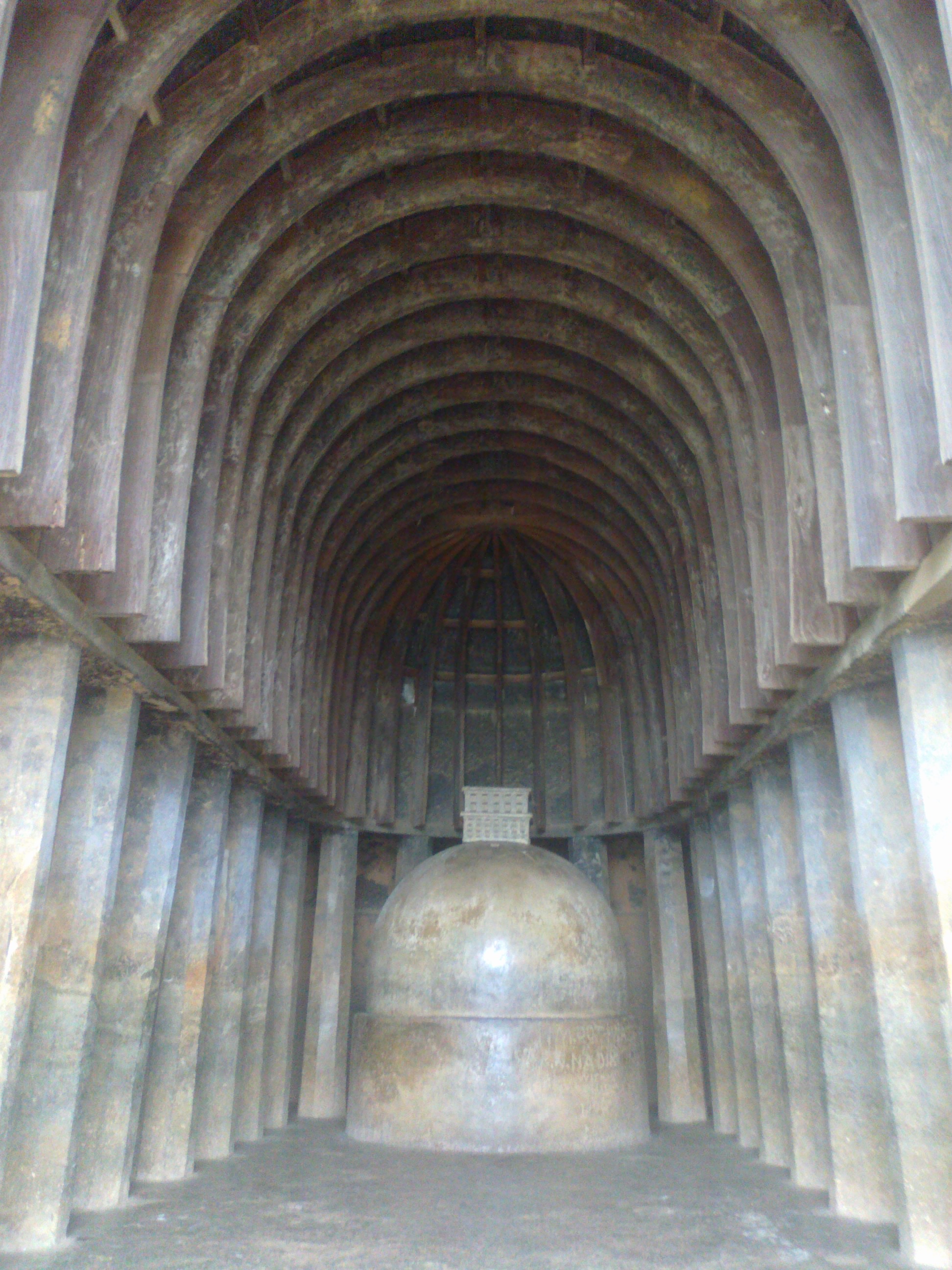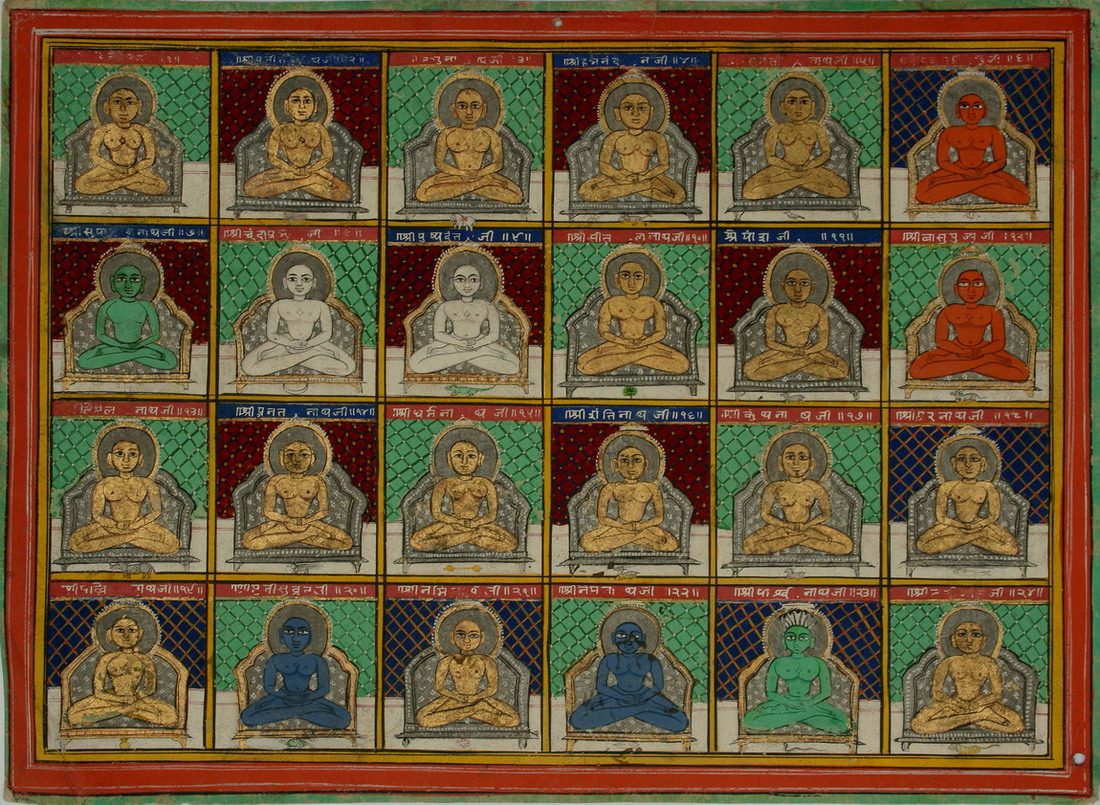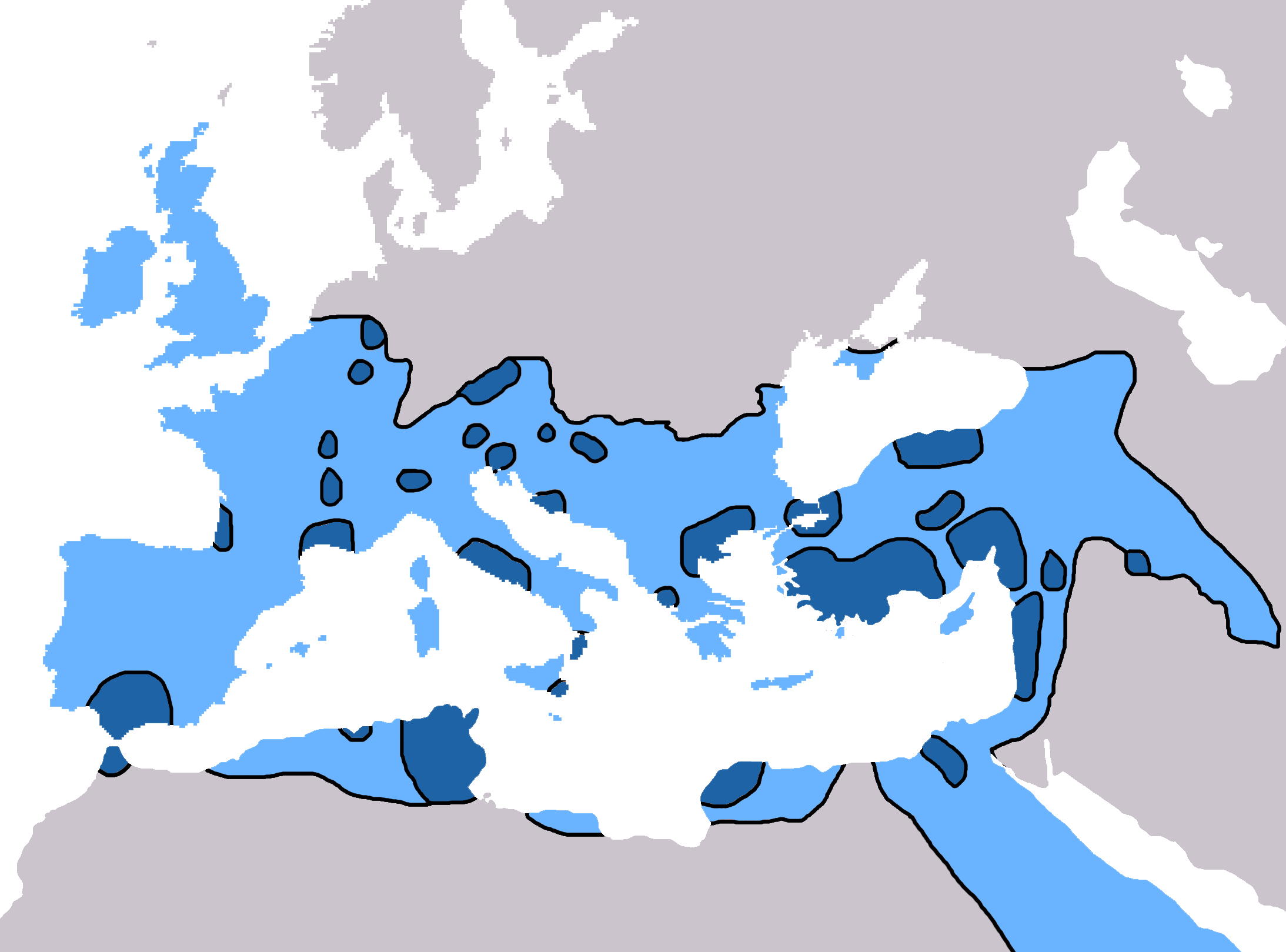|
Caityagriha
A chaitya, chaitya hall, chaitya-griha, (Sanskrit:''Caitya''; Pāli: ''Cetiya'') refers to a shrine, sanctuary, temple or prayer hall in Indian religions. The term is most common in Buddhism, where it refers to a space with a stupa and a rounded apse at the end opposite the entrance, and a high roof with a rounded profile. Strictly speaking, the chaitya is the stupa itself, and the Indian buildings are chaitya halls, but this distinction is often not observed. Outside India, the term is used by Buddhists for local styles of small stupa-like monuments in Nepal, Cambodia, Indonesia and elsewhere. In Thailand a stupa itself, not a stupa hall, is called a chedi, a local Thai word derived from the Pali Cetiya. In the historical texts of Jainism and Hinduism, including those relating to architecture, ''chaitya'' refers to a temple, sanctuary or any sacred monument. Most early examples of chaitya that survive are Indian rock-cut architecture. Scholars agree that the standard form follo ... [...More Info...] [...Related Items...] OR: [Wikipedia] [Google] [Baidu] |
Bhaja Caves Amit R Mahadik 05
Bhaja Caves are a group of 22 rock-cut caves dating back to the 2nd century BC located off the Mumbai - Pune expressway near the city of Pune, India. The caves are 400 feet above the village of Bhaja, on an important ancient trade route running from the Arabian Sea eastward into the Deccan Plateau (the division between North India and South India). The inscriptions and the cave temple are protected as a Monument of National Importance, by the Archaeological Survey of India per Notification No. 2407-A. It belongs to the Early Buddhist schools in Maharashtra. The caves have a number of stupas, one of their significant features. The most prominent excavation is its chaitya (or ''chaityagrha'' – Cave XII), a good example of the early development of this form from wooden architecture, with a vaulted horseshoe ceiling. Its vihara (Cave XVIII) has a pillared verandah in front and is adorned with unique reliefs. These caves are notable for their indications of the awareness of wooden a ... [...More Info...] [...Related Items...] OR: [Wikipedia] [Google] [Baidu] |
Aisle
An aisle is a linear space for walking with rows of non-walking spaces on both sides. Aisles with seating on both sides can be seen in airplanes, in buildings such as churches, cathedrals, synagogues, meeting halls, parliaments, courtrooms, theatres, and in long passenger vehicles. An aisle floor may be level or, as in theatres, sloping upward from a stage. Aisles also cross through shops, where they have shelving on either side; warehouses, flanked by storage pallets; and factories, where they separate different work areas. In health clubs, exercise equipment is normally arranged along aisles. They are distinguished from corridors, hallways, walkways, footpaths, pavements (''American English'' sidewalks), trails, paths and open areas of buildings: aisles lie between other open or seating areas, which are all enclosed within a structure. Spaces between buildings are not considered aisles, regardless of their size. The word is related to French ''aile'' (wing). Typic ... [...More Info...] [...Related Items...] OR: [Wikipedia] [Google] [Baidu] |
Robert Buswell Jr
Robert Evans Buswell Jr. (born 1953) is an American academic and writer on Korean Buddhism and Chinese Buddhism as well as Korean religions in general. He is Distinguished Professor of Buddhist Studies at the University of California, Los Angeles and founding director of the Academy of Buddhist Studies () at Dongguk University, Korea's main Buddhist university. He retired from UCLA in 2022. Education Buswell began his undergraduate education at the University of California, Santa Barbara and attended between September, 1971 and December, 1972. His focus was Asian Studies. Buswell then left the United States and became a Buddhist monk in Thailand, then Taiwan, and finally The Republic of Korea where he spent five years at Songgwangsa. This experience was related in his book ''The Zen Monastic Experience: Buddhist Practice in Contemporary Korea''. He did extensive fieldwork in Buddhist Monasticism between 1972 and 1979 at Wat Bovoranives, Bangkok, Thailand, in 1972 and 1973 ... [...More Info...] [...Related Items...] OR: [Wikipedia] [Google] [Baidu] |
Jan Gonda
Jan Gonda (14 April 1905 – 28 July 1991) was a Dutch Indologist and the first Utrecht professor of Sanskrit. He was born in Gouda, in the Netherlands, and died in Utrecht. He studied with Willem Caland at Rijksuniversiteit, Utrecht (since 1990 ) and from 1932 held positions at Utrecht and Leiden. He held the positions of Chair of Sanskrit succeeding Caland from 1929, as well as of Indology from 1932. He published scholarly articles on Indian Sanskrit and Indonesian Javanese texts for sixty years. In 1952, he published his monumental work on ''Sanskrit in Indonesia''. His contributions to philology and Vedic literature has been oft-cited. Gonda is recognized as one of the twentieth century's leading scholars of Asian language, literature and religion, particularly on texts and topics related to Hinduism and Buddhism. He wrote with ease and elegance in Dutch, English and German, and had a breath-taking range of interests from the ancient literature of Indonesia and India to c ... [...More Info...] [...Related Items...] OR: [Wikipedia] [Google] [Baidu] |
Vedas
FIle:Atharva-Veda samhita page 471 illustration.png, upright=1.2, The Vedas are ancient Sanskrit texts of Hinduism. Above: A page from the ''Atharvaveda''. The Vedas ( or ; ), sometimes collectively called the Veda, are a large body of religious texts originating in ancient India. Composed in Vedic Sanskrit, the texts constitute the oldest layer of Sanskrit literature and the oldest Hindu texts, scriptures of Hinduism. There are four Vedas: the Rigveda, the Yajurveda, the Samaveda and the Atharvaveda. Each Veda has four subdivisions – the Samhitas (mantras and benedictions), the Brahmanas (commentaries on and explanation of rituals, ceremonies and sacrifices – Yajñas), the Aranyakas (text on rituals, ceremonies, sacrifices and symbolic-sacrifices), and the Upanishads (texts discussing meditation, philosophy and spiritual knowledge).Gavin Flood (1996), ''An Introduction to Hinduism'', Cambridge University Press, , pp. 35–39A Bhattacharya (2006), ''Hindu Dharma: Introduc ... [...More Info...] [...Related Items...] OR: [Wikipedia] [Google] [Baidu] |
Tirthankara
In Jainism, a ''Tirthankara'' (; ) is a saviour and supreme preacher of the ''Dharma (Jainism), dharma'' (righteous path). The word ''tirthankara'' signifies the founder of a ''Tirtha (Jainism), tirtha'', a fordable passage across ''Saṃsāra (Jainism), saṃsāra'', the sea of interminable birth and death. According to Jains, ''tirthankaras'' are the supreme preachers of ''dharma'', who have conquered ''saṃsāra'' on their own and made a path for others to follow. After understanding the true nature of the self or soul, the ''Tīrthaṅkara'' attains ''kevala jnana'' (omniscience). A Tirthankara provides a bridge for others to follow them from ''saṃsāra'' to ''moksha'' (liberation). In Jain cosmology, the wheel of time is divided into two halves, Utsarpiṇī', the ascending time cycle, and ''avasarpiṇī'', the descending time cycle (said to be current now). In each half of the cycle, exactly 24 ''tirthankaras'' grace this part of the universe. There have been infini ... [...More Info...] [...Related Items...] OR: [Wikipedia] [Google] [Baidu] |
Mathura
Mathura () is a city and the administrative headquarters of Mathura district in the states and union territories of India, Indian state of Uttar Pradesh. It is located south-east of Delhi; and about from the town of Vrindavan. In ancient times, Mathura was an economic hub, located at the junction of important caravan (travellers), caravan routes. The 2011 Census of India estimated the population of Mathura at 441,894. In Hinduism, the birthplace of Krishna, one of the main deities in that religion, is believed to be located in Mathura at the Krishna Janmasthan Temple Complex. It is one of the Sapta Puri, the seven cities considered holy by Hindus, also is called Mokshyadayni Tirth. The Kesava Deo Temple was built in ancient times on the site of Krishna's birthplace (an underground prison). Mathura was the capital of the kingdom of Surasena, ruled by Kamsa, the maternal uncle of Krishna. Mathura is part of the Krishna circuit (Mathura, Vrindavan, Barsana, Govardhan, 48 kos pa ... [...More Info...] [...Related Items...] OR: [Wikipedia] [Google] [Baidu] |
Kankali Tila
''Kankali Tila'' (also Kankali mound or Jaini mound) is a mound located at Mathura in the Indian state of Uttar Pradesh. The name of the mound is derived from a modern temple of Hindu goddess Kankali. The famous Jain stupa was excavated here in 1890-91 by Alois Anton Führer (Dr. Führer). The mound almost rectangular in shape is 500 feet long by 350 feet broad. ''Kankali Tila'' brought forth many treasures of Jain art. The archaeological findings testifies the existence of two Jain temples and ''stupas''. Numerous Jain sculptures, ''Ayagapata, Ayagapattas'' (tablet of homage), pillars, crossbeams and lintels were found during archaeological excavations. Some of the sculptures are provided with inscriptions that report on the contemporary society and organization of the Jain community. Most sculptures could be dated from the 2nd century BC to the 12th century CE, thus representing a continuous period of about 14 centuries during which Jainism flourished at Mathura. These scu ... [...More Info...] [...Related Items...] OR: [Wikipedia] [Google] [Baidu] |
Sanskrit
Sanskrit (; stem form ; nominal singular , ,) is a classical language belonging to the Indo-Aryan languages, Indo-Aryan branch of the Indo-European languages. It arose in northwest South Asia after its predecessor languages had Trans-cultural diffusion, diffused there from the northwest in the late Bronze Age#South Asia, Bronze Age. Sanskrit is the sacred language of Hinduism, the language of classical Hindu philosophy, and of historical texts of Buddhism and Jainism. It was a lingua franca, link language in ancient and medieval South Asia, and upon transmission of Hindu and Buddhist culture to Southeast Asia, East Asia and Central Asia in the early medieval era, it became a language of religion and high culture, and of the political elites in some of these regions. As a result, Sanskrit had a lasting effect on the languages of South Asia, Southeast Asia and East Asia, especially in their formal and learned vocabularies. Sanskrit generally connotes several Indo-Aryan languages# ... [...More Info...] [...Related Items...] OR: [Wikipedia] [Google] [Baidu] |
Christian Church
In ecclesiology, the Christian Church is what different Christian denominations conceive of as being the true body of Christians or the original institution established by Jesus Christ. "Christian Church" has also been used in academia as a synonym for Christianity, despite the fact that it is composed of multiple churches or denominations, many of which hold a doctrinal claim of being the one true church to the exclusion of the others. For many Protestantism, Protestant Christians, the Christian Church has two components: the church visible, institutions in which "the Bible, Word of God purely preached and listened to, and the sacraments administered according to Christ's institution", as well as the church invisible—all "who are truly Salvation in Christianity, saved" (with these beings members of the visible church). In this understanding of the invisible church, "Christian Church" (or Catholic (term), catholic Church) does not refer to a particular Christian denomination, ... [...More Info...] [...Related Items...] OR: [Wikipedia] [Google] [Baidu] |
James Fergusson (architect)
James Fergusson FRS (22 January 1808 – 9 January 1886) was a Scottish architectural historian, mainly remembered for his interest in Indian historical architecture and antiquities. He was an important figure in the 19th-century rediscovery of ancient India. He was originally a businessman, and though not formally trained as an architect, designed some buildings and decorative schemes. Life Education and India Fergusson was born in Ayr, the son of William Fergusson (1773–1846) an army surgeon turned medical writer, and inspector of hospitals. After being educated first at the Royal High School, Edinburgh, and then at a private school in Hounslow, he went to India to work as a manager at his family's mercantile house of Fairlie, Fergusson & Co. of Calcutta. Here he became interested in the remains of the ancient architecture of India, little known or understood at that time. The successful conduct of an indigo factory, as he states in his own account, enabled him t ... [...More Info...] [...Related Items...] OR: [Wikipedia] [Google] [Baidu] |








